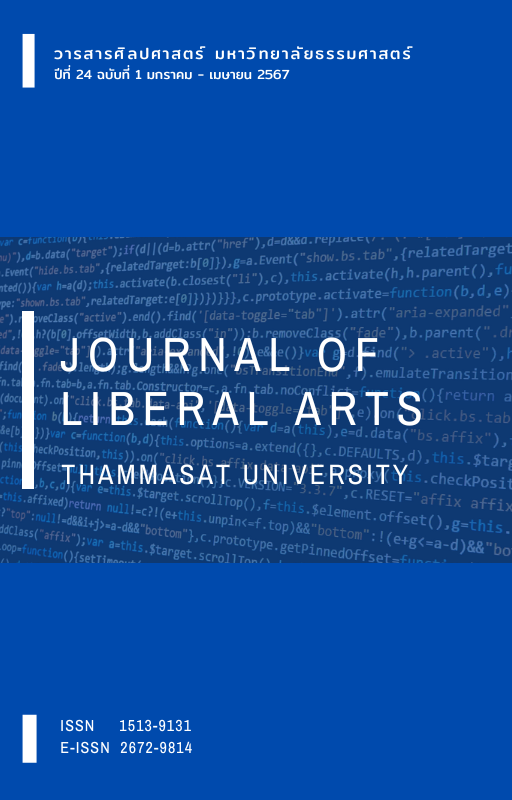Comparative Analysis of Advertising Texts of Popular Thai Goods and Services of Different Categories for Russians: Linguo-stylistic Devices and Discursive Aspects
Main Article Content
Abstract
This research presents a comparative analysis of advertising texts of popular Thai products and services from various categories targeting the Russian audience. The research aims to identify linguistic and stylistic devices and discursive aspects employed in these texts, as well as to determine similarities and differences among them. The findings of the research revealed that the main language devices used in these texts, such as epithets, terms, metaphors, idioms, neologisms, mention of the opportunity to explore the culture and nature of the country and the patronage of the royal family were identified. All product and service categories employ emotional appeal to the audience, seeking to evoke positive emotions and convince them of the attractiveness of the products and services. In addition, some similarities and differences in language devices, which are related to the uniqueness and individuality of the products and services as well as the linguistic adaptation to the target audience were found.
Downloads
Article Details

This work is licensed under a Creative Commons Attribution-NonCommercial-NoDerivatives 4.0 International License.
References
Aporbo, R. (2022). A discourse analysis of fast food advertisements. International Journal of Research Publications, 111(1), 300-317.
Belch, G. E., & Belch, M. A. (2014). Advertising and promotion: An integrated marketing communications perspective. McGraw-Hill Education.
Bushra, N. R. (2022). A stylistic analysis of advertising discourse: a case study of facebook commercial advertisement. Route Education and Social Science Journal, (Special Issue), 42-59.
Chairerk, W., & Anunsiriwat, P. (2016). The linguistic strategies used to communicate masculine ideology in GM (Gentleman’s Magazine). Journal of Humanities and Social Sciences, Thaksin University, 11(2), 75-96.
Chamwong, W., Praingam, K., & Paijitr, P. (2015). The stratigies of using language in cosmetics advertising. Rajamangala University of Technology Rattanakosin.
Chen, W. (2019). Stylistic devices in Thai advertising: A corpus-based study. Linguistics and Semiotics, 15(4), 112-128.
Chomsuwan, P. (2008). A content analysis of forms and languages used in advertising copy of resort on the internet [Master’s Thesis]. University of the Thai Chamber of Commerce.
Cook, G. (2001). The discourse of advertising. Routledge.
Dyer, G. (1982). Advertising as communication. Routledge.
Johnson, S. (2020). Discourse strategies in Thai advertising: A comparative analysis of different product categories. International Journal of Applied Linguistics, 25(3), 78-94.
Kim, J. (2017). Metaphorical representations in Thai advertising: A comparative study of cosmetic and food products. Journal of Language and Culture, 12(1), 102-118.
Lerlertyuttitham, P. (2015). Advertising language and persuasion. Manusya: Journal of Humanities, 21(Special Issue), 50-59.
Limkulacomn, S. (1991). Strategies of word use in Thai in television and magazine advertising [Master’s thesis]. Chulalongkorn University.
Mokshin, S. (2021). The manipulation of the advertising discourse: Rhetoric and stylistic aspects. Propósitos y Representaciones, 9(SPE1), e916. https://doi.org/10.20511/pyr2021.v9nSPE1.916
Phakdeephasook, S. (2009). Discourse of femininity in advertisements in thai health and beauty magazines. Manusya: Journal of Humanities, 12(1), 63-89.
Smith, J. (2018). Language and advertising: A linguistic analysis of Thai advertising texts. Journal of Linguistics and Communication Studies, 20(2), 45-63.
Solomon, M. R., Russell-Bennett, R., & Previte, J. (2012). Consumer behavior: Buying, having, and being. Pearson Australia.
Wang, L. (2016). Pragmatic strategies in Thai advertising discourse: A case study of tourism products. Journal of Pragmatics, 40(2), 215-231.
Zafar, I. B., Aasma, N., & Anila, K. (2012). An analysis of Pakistani advertizing discourse (tv commercials). Elementary Education Online, 19(3), 2998-3008.
Лю, Чуньвэй. (2001). Тропы и фигуры речи в современных рекламных текстах: учебное пособие. ИГЛУ.
Скнарев, Д. С. (2014). Языковые средства создания образа в рекламе таиланда для русскоговорящих туристов. Современные проблемы науки и образования, 6, 1-8.
Терпугова, Е. А. (2000). Рекламный текст как особый тип императивного дискурса [Диссертация кандидата филологических наук]. Иркутский государственный университет.
Франтасова, А. М. (2015). Журналистика и массовые коммуникации. Журналистика и массовые коммуникации, 3(141), 64-68.

